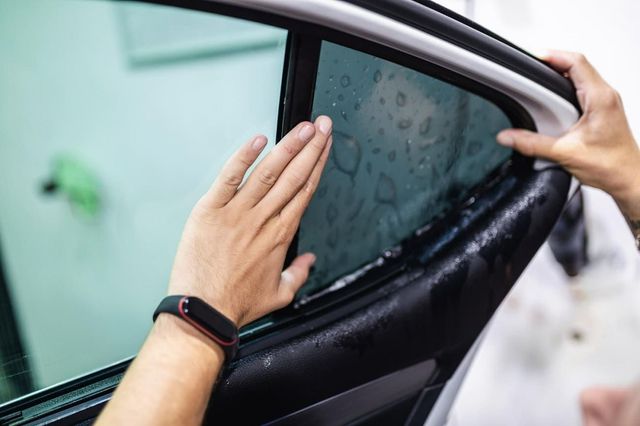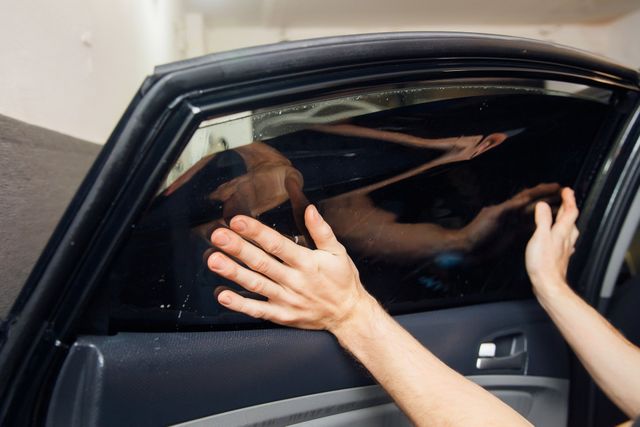How Window Tinting Can Reduce Glare and Improve Road Safety
Wiki Article
Window Tinting Options: Discover the Right Shade for Your Style and Requirements
Selecting the appropriate window tint for your car entails a mindful consideration of various elements, including personal aesthetic appeals, functional requirements, and legal constraints. With choices ranging from light tintss that provide very little privacy to darker tones that boost privacy, the options can be frustrating.Recognizing Window Tinting Degrees
When considering window tinting, it is important to comprehend the various degrees of tint readily available, as they significantly impact both looks and functionality. Window tinting is categorized based on Visible Light Transmission (VLT) portions, which show the amount of light permitted to go through the glass. The VLT portion can range from really light (over 70%) to really dark (below 5%)The primary levels of tint include clear, which offers UV protection without altering visibility; light tint (over 50% VLT), which a little decreases glare while preserving presence; medium tint (around 35% VLT), striking a balance in between privacy and light transmission; and dark tint (listed below 20% VLT), supplying substantial privacy and warmth decrease however restricting outward visibility.
Recognizing these levels is essential as they can influence driving safety and security, lawful conformity, and individual comfort. In addition, local laws usually dictate permissible tint levels, varying by state or municipality. Before picking a color, it is a good idea to research and ensure adherence to these regulations while taking into consideration personal preferences for style and useful advantages.
Popular Tint Shades Explained

Among the most preferred alternatives is the classic dark tint, typically ranging from 20% to 5% VLT (Visible Light Transmission) This shade offers optimum personal privacy and a streamlined, advanced look. It successfully blocks UV rays and warm, making it excellent for bright climates, though it might limit visibility during the night.
On the other hand, lighter tones such as 35% or 50% VLT offer a more refined look while still providing some degree of personal privacy. These tones are excellent for those seeking an equilibrium between aesthetics and functionality, as they permit better visibility and adhere to different legal criteria.
One more emerging preference is the ceramic tint, which can be available in a variety of shades - window tinting. It offers premium heat denial and UV defense without dramatically changing the automobile's appearance

Lawful Rules for Window Tinting
Understanding the lawful policies surrounding window tinting is essential for lorry proprietors looking to customize their cars. Each state in the united state has specific regulations governing the darkness or agility of window tintss, usually measured by Visible Light Transmission (VLT) percentage. VLT refers to the quantity of light that can go through the film and the glass incorporated.In several states, policies determine various VLT percentages for different windowss, consisting of front windscreens, side windowss, and rear windowss. Some states may permit a tint of 70% VLT for windscreens while allowing darker tintss for rear windowss. In addition, specific states have limitations on reflective tintss, which can create glare for other chauffeurs.
Failure to comply with these policies can lead to penalties, mandated removal of the tint, and raised insurance coverage premiums. Lorry proprietors need to get in touch with local regulations or state DMV internet sites to guarantee they are within legal limitations prior to waging installment. Understanding these laws not only helps avoid lawful repercussions but additionally makes certain a risk-free driving experience.
Advantages of Various Tint Materials
Discovering the benefits of numerous tint materials exposes considerable advantages that can improve both the performance and visual allure of a car. Each material supplies distinctive attributes suited to details needs and preferences.Dyeded window films are popular for their affordability and capacity to lower glare. They efficiently obstruct UV rays, shielding the inside from fading, though they might not give the greatest heat rejection. Metalized films, on the other hand, deal remarkable warm reduction and UV defense as a result of their reflective homes. They Learn More Here can boost personal privacy and security yet may hinder digital signals.
Ceramic window films stand for a premium choice, giving remarkable warmth being rejected while keeping presence. They are non-metallic, therefore avoiding any kind of signal disturbance, and are highly durable, standing up to scratches and fading over time. Furthermore, ceramic films do not have dyes, making sure a longer-lasting look.
Last but not least, hybrid films combine aspects from dyeded and metalized alternatives, using a balanced performance in regards to warmth being rejected, glow decrease, and price. Each tint product offers special functions, enabling vehicle proprietors to choose the very best suitable for their lifestyle and visual preferences, ultimately improving their driving experience.
Picking the Right Tint for You
Discovering the right window tint includes taking into consideration numerous factors, including individual choices, lorry kind, and local guidelines. Evaluate your individual style and wanted level of privacy, as these will certainly guide your choice of tint shade. Darker tintss provide improved privacy but might not appropriate for all motorists, particularly those that like a more open feeling inside their car.Next, consider your vehicle kind, as the size and shape of windowss can affect the efficiency of certain tintss. Larger windowss might benefit from reflective tintss that minimize glare while smaller sized windowss may be extra fit to dyeded films that use refined visual appeals.
Furthermore, it's crucial to check neighborhood policies pertaining to window tinting. Lots of states impose constraints on the permitted darkness and reflectivity, especially for front windowss. Compliance with these regulations is vital to prevent fines and guarantee safety.
Finally, assess the tint material that ideal fits your needs. Options include dyeded, metalized, ceramic, and crossbreed films, each offering one-of-a-kind advantages associating with warmth being rejected, UV defense, and durability. By thinking about these elements, you can confidently select a home window tint that lines up with your style and practical needs.
Conclusion
Finally, picking the ideal window tint calls for cautious factor to consider of numerous elements, consisting of VLT portions, regional guidelines, and the preferred visual. Different tint materials offer one-of-a-kind benefits that can improve automobile convenience and security. By thoroughly understanding the offered options and straightening them with practical needs and specific preferences, one can attain an ideal balance between design and functionality in window tinting options.Picking the proper window tint for your lorry involves a careful consideration of various aspects, consisting of personal aesthetic appeals, practical requirements, and legal limitations. Each state in the United state has details laws regulating the darkness or lightness of window tintss, often measured by Visible Light Transmission (VLT) portion. Some states might enable a color of 70% VLT for content windscreens while permitting darker tintss for back windowss.Discovering the right window tint entails thinking about numerous factors, consisting of individual choices, automobile type, and neighborhood policies.In conclusion, picking the suitable window tint requires mindful consideration of various elements, including VLT percents, read this local laws, and the preferred visual.
Report this wiki page